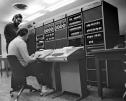I'll be posting my findings as things go on. I'm trying to build more complicated configs but it's quite hit and miss. So far:
1. what ever you do, turn off all unnecessary eye candy, monitoring software, etc in Windows to get more I/O throughput. It can divide by 4 the time to install from the cpio archive on atom systems, so imagine on your superduper Core I7...
2. you *must* give the machine the hostname "amix" or the fixdisk will exit complaining that it's not dealing with AMIX.
3. fixdisk + update disk work, but that'll bork networking. Install the X11R5 package for PicassoII and the kernel recompile will restore networking.
4. How to import stuff easily? Well, I have, like most of you, a box running some *nix/bsd thing, and it shares the homedir using samba. This is fairly crucial so you can download, unarchive, then tar whatever you need to import. Then you set up a HDF at SCSI4 or 5 that point to that tar archive, reboot, and you should be able to untar from /dev/dsk/c4d0s0 or c5.
5. That pesky installation file. Once you've achieved a working HDF, back it up. Right away. And make 2 copies. You can now procede with testing differents configs, like loads of swap (512M) and maybe a separate /usr or /home partition. To do all this, you need the damn install file ( /etc/profile on the root.adf) to do it's job. It's not very good at it, and likes to hang at various points for hours for no reason. First thing to do is to boot up whatever linux install you have handy, loop mount the root.adf as a sysv fs and edit the /etc/profile near the end when it starts processing the cpio archive. Just comment all that rubbish about dd etc out and put
That's assuming you've got the archive set up as an HDF on SCSI4. If you've got a working install, copy that /etc/profile somewhere handy (not in /etc, obviously... ) and copy over all of the content of /etc, since it has a few binaries that aren't in the final install and can be useful.
6. I find easiest to let the floppy install do the partitioning, since neither sysadm (the inbuilt menued admin system) nor rdb are very effective or userfriendly (effective not for sysadm, and userfriendly not for rdb). It then claims to "check the partitions" but hangs half the time, that's when it's time to reboot into your working install and do the fs creation yourself. This oddly requires you to provide the partition size! So do this:
Code:
Select all
rdb -p a /dev/dsk/c5d0s0
mkfs -F ufs /dev/dsk/c5d0sa sizethatrdbgaveya
a is the number of the partition. Usually 1 for the root partition, 2 for swap, 3 for boot, and 4 for Extra, which you can do anything you want to.
7. The kernel is written to a 2M boot partition, always the third partition of the disk. This is achieved by:
Code:
Select all
cd /stand
make bootpart KERNEL=yourkernel (usually unix)
to actually build a fresh kernel, you need to go into /usr/sys and just do make. For linux folks, no there's no choosing options. This is SysVR4.
8. Unlike what I stated before, you can boot disks over 1G (I haven't tried over 2) but no partition can be over 1G. I have a working install with 950M for / . I'm not sure about the max size for swap, it barfed badly at 512M on initial boot, but that may just have been because of my manual install. You have to be very careful to use rdb to label the FS of each partition using a specific hex code that's in the install script. It's also in the manpage iirc.
9. It supports an unusual array of filesystems, including distributed ones. I've never heard of half of them, so if someone could chip in...
FS supported according to sysadm: bfs, fd, fifofs, namefs, nfs, procfs, rfs, s5, specfs, ufs, xnamfs .
10. X11 is nice, but I can't get Open Look working, it's complaining about missing it's default font and it's not provided by the install. Tried to symlink some other same size font, it won't take it. That leaves you with twm (in magenta, not green), tvtwm, and maybe some other thing. And the keyboard does whatever it pleases in X: y and z inverted, ' becomes paste, / migrates to 7, it sort of becomes some variant of a euro keyboard basically, but which one I'm not sure.
11. bash and ksh are provided, but bash in amiga console ignores the arrowpad so no backscrolling commands and whatnot. Works fine in X11.
12. The manpages aren't too bad and do explain a lot but I need to delve in much further. Apropos works!
13. Networking: (yes it needs to be at 13 the way it works...) TCP/IP works, but as in an ancient system. One which defaults to using a hosts file, not DNS. Now that the amigaunix.com site is back up, you better read the page there on how to do it all, plus, in WinUAE you're using SLIRP, so your host *has* to be 10.0.2.15 and the gateway *has* to be 10.0.2.2. DNS is at 10.0.2.3. Make sure you set it up right, with named (probably v4, violently ugly...) running so that you can do NFS/FTP/Telnet/all that stuff. ICMP doesn't work beyond the gateway, that's the nature of SLIRP apparently.
14. Speed up: turn off unnecessary services the usual way (renaming...) and get syslog running by editing the /etc/init.d/syslog file to remove that exit line. Can come in handy.
All in all, it works, but it takes a while to get everything working and then you feel the urge to install some updates, like an egrep that's recursive... amigaunix.com and amixbp.sf.net have stuff, so that could help. I have screen now!


















 .
.